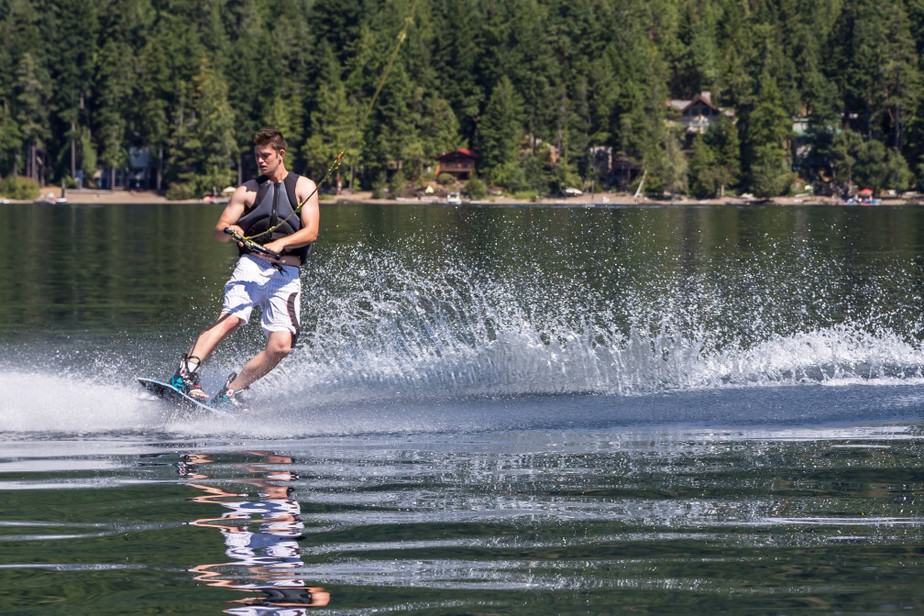Can you Wakesurf or Wakeboard Behind a Jet Ski?
If you are like most water sports lovers, it is important to be on the water as much as possible, but a method of getting out there may not readily available.
If you are interested in wakeboarding or wakesurfing you may be wondering if you can do either behind a Jet Ski to try it out before spending the big money on a wakeboard boat. You may have thought that since it is a watercraft and there is a way to connect a tow rope that it might do the trick.
You may have even seen someone trying it, or heard someone talking about wakeboarding or wakesurfing behind a Jet Ski and wondered if it would work for you. Many people have asked this question, and the answer may surprise you.
I’ve tried in the past to wakeboard behind a Jet Ski and have first-hand experience about if it works.
Can you Wakesurf or Wakeboard Behind a Jet Ski?
Can you wakesurf or wakeboard behind a Jet Ski? In short, the answer is yes but it can be very challenging.
Jet Ski’s are amazing machines. They are light, powerful and capable of doing things you will only be able to experience on a jet ski. Overall, they are a seriously fun way to spend the day on the water if you are ready to goof off and be soaked as soon as you get started.
Some things to do on a jet ski are jumping waves, Jet Ski fishing, Jet Ski camping, and going really fast then turning on a dime. There is so much to be done on a Jet Ski that it is easy to spend an entire day on the water while time flies by.
There is a sense of freedom that comes along with riding a Jet Ski because it is just you sitting on top of the water without a lot in between, and the wind in your hair. With everything Jet Ski’s are great at, they are not as well suited for wakesurfing and wakeboarding.

How does a Jet Ski work?
Jet Ski’s are personal watercraft (PWC) that use jet propulsion to create thrust that pushes the craft forward, hence the name “Jet Ski.” The jet ski has a water-cooled engine and a transmission just like most other watercraft, but that’s about where the similarities end.
Instead of using a propeller that turns in the water to create thrust, the Jet Ski uses an impeller to suck water into the system, then pushes it out the back of the Jet Ski with a great amount of pressure.
On a boat, a propeller is positioned on the outside and is attached to the engine. It has blades that are slightly curved and attached to the hub (the base of the propeller, sometimes called the “boss”) at an angle (referred to as “pitch”).
Since the pitch of the blades stays in a fixed position, the hub and blades are cast from a single piece of metal, creating additional strength by removing any weakness attachment points would create.
The torque created by the engine spins the propeller and creates thrust by creating a difference in pressure between the water and propeller, accelerating the water backward (behind the boat) then pushing the boat forward. When the steering wheel is turned and the propeller changes direction, the boat also changes direction.
Since the propeller is on the outside of the boat, part of its job is to grip the water to help create stability when turning. If a turn is taken too sharply, sometimes a propeller will lose its grip and will feel like it is slipping.
An impeller, however, uses a slightly different method for creating thrust. On the bottom of a Jet Ski is a grate covering a hole.
The hole leads to a pipe that’s about 5” in diameter and leads to the water exit nozzle at the rear of the Jet Ski. Inside the pipe is where the impeller is housed. Similar to a propeller, the impeller has blades with a fixed pitch surrounding a hub.
The impeller sucks water through the grate and into the pipe and creates thrust by forcing the water towards and through the water exit nozzle.
The water exit nozzle is slightly smaller than the diameter of the pipe and helps create more pressure in the water being forced through it. Also, the nozzle moves based on the direction the handlebar is turned and is used to steer the Jet Ski.
A jet propulsion system like this can create an amazing amount of thrust while also providing an incredibly nimble driving experience. Since there isn’t a propeller that is used to grip the water during turns, as soon as the water exit nozzle changes direction there is an immediate response and change in direction of the Jet Ski, letting the craft turn almost on a dime if you want it to.

Attempting To Wakeboard and Wakesurf Behind a Jet Ski
Jet Skis are relatively small and light compared to other watercraft. This presents some unique opportunities, as well as some unique challenges. The opportunity is found in the speed, responsiveness, and ability to find hard to reach areas.
Because of how lightweight they are, Jet Skis can use a smallish engine and still create enough power and thrust to go up to around 70 mph and get there very quickly.
It seems like most Jet Skis on the market top out within 5 mph of each other, with the major focus now being who can get to their top speed the fastest.
To keep the size and weight down, there isn’t a lot of extra room on the PWC. Typically there is a dry compartment in front of the handlebars and a small compartment right in front of the seat.
Sometimes, you will also find a storage compartment under the seat, but since the engine is housed under the seat, there isn’t too much extra room most of the time.
When wakeboarding and wakesurfing, two of the most important factors are producing a big wake and being able to control the speed of the boat during take-off and once on plane. In a wakeboard boat, both are relatively easy to accomplish.
There is more weight in the boat itself and plenty of room to add extra weight to create a big wake. Also, speed is easily controlled by a throttle lever that can be moved in as large, or small, of increments as you like.
Once the throttle lever is where you want it, it stays in place. Boats today typically also have speed control where you can set a specific speed and the boat works to maintain that speed (like cruise control in a car).
On a Jet Ski, creating a large wake is problematic. Jet Skis are lightweight and there isn’t room to add more weight at the rear other than having a person sitting on the back.
Still, the wake will be narrow and will never be big enough to do much on a wakeboard and wouldn’t provide a large enough wake to push a surfboard. When wakesurfing, the surfboard would likely have a hard time catching the wave and staying on it because of the limited size and power of the wake.
Speed on a Jet Ski is controlled by a lever on the handlebar – when the lever is pulled towards the handle the Jet Ski moves forward and when the handle is released the Jet Ski slows down.
Because of this setup, going a specific speed can be challenging. Jet Skis are set up to go from 0 mph to top speed quickly and then stay there.
When wakeboarding and wakesurfing it is important to be able to control take-off speed to avoid ripping the tow rope handle from the hands of the rider, then to keep the speed between 15 mph and 25 mph while the rider is being towed, a good 45 mph to 55 mph below the top speed of a Jet Ski.
It can be done, but it takes the work of a skilled driver to keep the speed from fluctuating too much, and a skilled rider to respond to the inevitable fluctuations without falling.
Final Thoughts
All of this being said, it is possible, though very challenging, to wakeboard behind a jet ski and nearly impossible to wakesurf behind a Jet Ski.
In a pinch, you may be able to get up behind a Jet Ski on a wakeboard, though it will be challenging for the driver to keep the speed where it needs to be and there won’t be a whole lot you can do other than just ride around.
Jet Skis have plenty of power, it just isn’t delivered in a way that makes it easy to control the speed.
Part of the fun in wakeboarding behind a boat is being able to jump the wake and do tricks; the bigger the wake the better and having a smooth firm wake will provide a stable launching surface for the rider allowing them to get big air to clear the wake with ease, setting the stage for tricks to be done.
Jet Skis are incredibly fun and capable of doing a number of things, though they do some things better than others.



